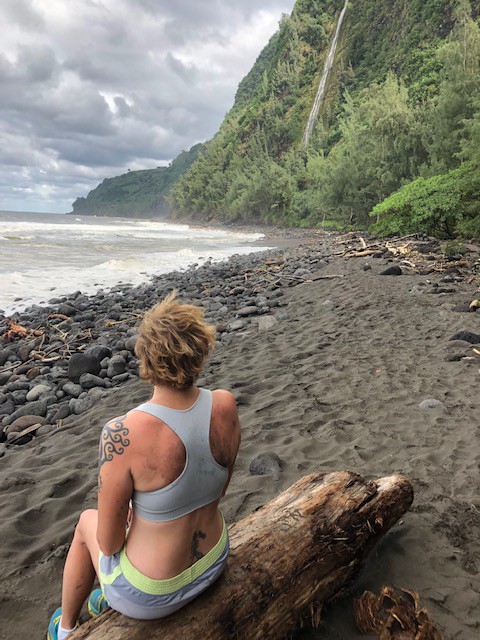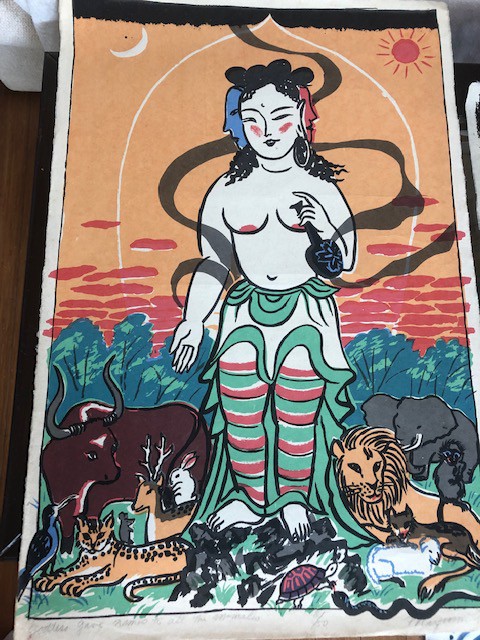I’ve often thought about the eternal round: of patterns, of cycles, of time and space, of existence as we know it. Like a snake swallowing its tail. Pain kisses the sole of pleasure. Hate and love are the same animal. I’ve built philosophical arguments in favor of these ideas. But all the effort has been toward proving it and making other people believe it rather than what it stands for. It’s a metaphor for something vaster.
I’ve had a vivid, recurring dream for several years. In it, I get suddenly confronted with exotic, wild sea and/or land creatures that captivate and scare me in equal measure. There was one where I sat looking out at a ship docked in a bay and the sea creatures came shooting out from the back of the ship and were dropped into the water, one by one. They were brightly-colored and many-tentacled. They were whale-like in size. Glittering, bright creatures released into the water. In another, I was with my girlfriend and our children by a body of water and a cliff and a paved area at the top of the cliff. Off the paved area was a steep road leading up. We had been looking out at the water and were about to make our way back up the steep hill with our kids. Her son in a wheelchair and my son a toddler, we were having a hard time. The wheelchair tipped backward and almost fell and my son was throwing himself on the ground having a tantrum. As we struggled with our kids, suddenly, hundreds of creatures came up over the side of the cliff and piled on the pavement. There were serpents and lizards and four-legged animals with fur, too. There were large insects and birds and turtles and fish flopping around.
What remained after these dreams was a feeling that the creatures had something to do with my creativity and my writing. They symbolized ideas and they came to me in such abundance and all at once. They came to me in ordinary moments and demanded my full attention. Their range—from cute and adorable to terrifying and deadly, from black and gray to brightly colored, from land-bound to sea-dwelling—and their coming together like that in once place intrigued me. But no matter how much I researched and thought about these specific dreams, they never made sense completely. Still, they stayed with me and I felt their weight.
A couple of weeks ago, I went with my girlfriend, Billi, to the big island of Hawaii for her birthday and our anniversary. Neither of us had ever been. She picked the places to stay. When we arrived and I heard that our first place was a remote seaside farm off the grid with no locks on the doors and an outdoor shower, I worried. I had a few valuable things with me, including laptops, and I couldn’t leave them in an unlocked cottage free for the taking. “I’ll lock things up in the car, I guess,” I said in my worried voice. “Let’s get there and see what it’s like,” she said.
When we arrived, we drove down a long, narrow, paved driveway toward the ocean through thick, jungle-like forest. Leaves and foliage scraped along both sides of the car as it cut through, its width just fitting on the narrow pavement with no shoulder. Slowly, I pulled up to a clearing with a house and a small group of people practicing archery. We parked the car among a few others, some of which looked broken down and permanently installed, and were directed toward the path to our cottage. We found the most magical seaside hut with big, open windows and light dancing on the floor and walls, which were decorated with art. The lamp shades, the carpets, even the pillows had been painted by someone in the most pleasing way. “An artist lives here,” Billi said. The cottage had a wide front porch opening to a slanting vista of green all the way down to the cliff, giving way to the vast body of water below. Vines and palms and fruit trees surrounded us. What we thought were night birds singing at dusk serenaded our arrival and we were in heaven. We walked the farm and whispered to each other and pointed and gasped. Orchids and other flowers and majestic trees and bursting gardens were everywhere. “Why are we whispering?” I asked. “Because, reverence,” she said. Instead of going back out for dinner, we stayed in our cottage enraptured by its beauty until dark closed around us and we slept like gods.
The next day, we inspected the paintings on the wall and the books in the space and noticed they were all by the same artist: Mayumi Oda. Featured in almost all of her paintings were topless women with prominent nipples. They wore skirts or pants and sometimes no pants either, but never a shirt. Except deep inside one of the books, we found some pieces depicting clothed women. Their hair is almost always black and most have red lips and cheeks. They were floating in the sea with fish or sitting in a garden with veggies shooting up all around them. In one book, we found an entire series of goddesses or Taras depicted in this manner. “These would make a great Tarot deck,” Billi said.
Encountering Mayumi was like being in the presence of that place: such power and spirit in such a compact package. She invited us into her studio with high ceilings and soaring windows with that wild green jungle shining through. She gave us a prototype of a tarot card deck using images of her Taras and asked that we use it and tell her about the experiences. A sort of focus group, she said. Only a handful of people have them, mostly her staff at the farm.
She showed Billi a print that was black and dark gray and an abstract rendering of a large goddess breastfeeding a child. It was called Mother Help Us and it had the words “Mother Help Us Outgrow Madness and Fear” layered within it. Mayumi said, “This Goddess came out of the Danube River.” Billi said, “My father was born alongside the Danube River.” Her eyes were wide. Her father recently died. Mayumi smiled, “The Goddesses of your culture are powerful.”
Looking through her other prints, I came across a colorful Tara that drew my attention. On the ground, all around the feet of the topless Tara were animals looking exotic and out of place. It was as though they were looking to her for something. I leaned forward and read the words at the bottom of the painting “Goddess Gave Names to All The Animals.” And it clicked: the diversity of life, the range of character—they’re symbols of the finer aspects of this existence. And they lay themselves at my feet to be told about. Not that this means I am the goddess, giving names to all the animals. It means, rather, that the animating force in me—that motivates me and drives me to write—is the goddess. And the metaphysical animals get named (identified and identified with) through story.
And when I’m in their presence, I feel the presence of god.
Mayumi closed that circle for me with her painting that she made in 1985 when I was 8 years old. About the age my daughter is now. It took me 34 years to find that painting that would close the loop that hadn’t yet started in linear time. Somehow, this calmed my anxieties about my 8-year-old daughter (because it’s scary but exciting to raise a girl in this misogynist, patriarchal, hetero-normative, white supremacist culture). Maybe it was the perspective. The backdrop of my whole past to measure her future against.
We wandered and swam around that wild island, among vibrant rainbows and bright fish and friendly dolphins and black, hardened volcanic flow—the substance made of the same base ingredients as my body, as all organic biological systems, all life. Asteroids smashed together and made a big ball that boiled with volcanoes for millennia, burping the building blocks of life up to the surface from deep within. Volcanoes make the world’s most fertile soil, they say. It takes 15,000 years for that black, hard rock to turn to fertile soil.
I had a conversation with my friend yesterday about time and space and how, along a linear time scale, this moment is so thin it’s barely perceptible. But zoom out, and it’s thinner still.



Recent Comments